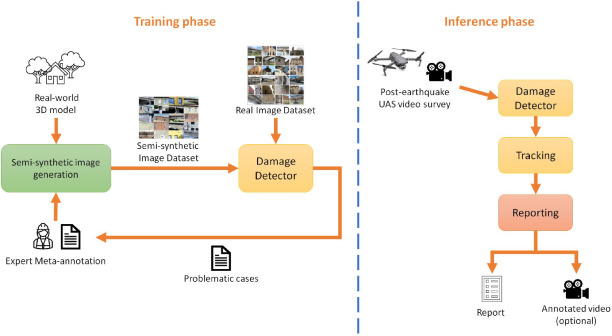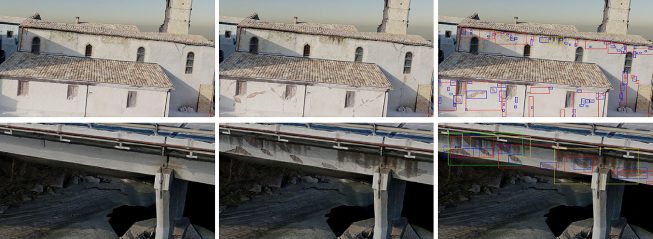Ricercatori di Fondazione Eucentre e del Laboratorio di Visione Artificiale del Dipartimento di Ingegneria Elettrica, Informatica e Biomedica dell’Università di Pavia, hanno recentemente pubblicato un innovativo studio sulla rivista Engineering Applications of Artificial Intelligence. L’articolo, intitolato Post-earthquake structural damage detection with tunable semi-synthetic image generation, è il risultato del lavoro congiunto di Piercarlo Dondi, Alessio Gullotti, Michele Inchingolo, Ilaria Senaldi, Chiara Casarotti, Luca Lombardi e Marco Piastra.
Il lavoro si inserisce in un contesto di crescente utilizzo dell’Intelligenza Artificiale (AI) per la gestione delle emergenze, con particolare attenzione al monitoraggio delle strutture colpite da eventi sismici. La ricerca propone una metodologia avanzata per il rilevamento automatico dei danni strutturali attraverso l’uso combinato di tecniche di Deep Learning e la generazione di immagini semi-sintetiche, superando una delle principali limitazioni dei modelli di intelligenza artificiale: la scarsità di dataset adeguati.
L’importanza del rilevamento rapido dei danni post-sismici
Dopo un terremoto, una delle operazioni più critiche è la valutazione della sicurezza degli edifici e delle infrastrutture per determinare se possono essere utilizzati senza rischi. Attualmente, questa attività è svolta attraverso ispezioni visive da parte di esperti, un processo che, seppur altamente qualificato, è estremamente dispendioso in termini di tempo e risorse. L’integrazione dell’Intelligenza Artificiale in questo processo potrebbe rappresentare un punto di svolta, permettendo di analizzare in tempi rapidi grandi quantità di dati, riducendo il carico di lavoro per i tecnici e migliorando la tempestività delle analisi.
L’uso di droni (Unmanned Aircraft Systems – UAS) è già diffuso nelle operazioni di ispezione post-sismica grazie alla loro capacità di acquisire immagini e video da punti di vista inaccessibili all’uomo, come, per esempio, durante i sopralluoghi di ponti, attività che la Fondazione Eucentre svolge da tempo. La sfida principale rimane comunque l’analisi e l’interpretazione delle immagini in modo automatico e affidabile.
Un metodo innovativo per la creazione di dataset realistici
Uno degli ostacoli principali nello sviluppo di sistemi di rilevamento automatico dei danni è la mancanza di dataset di immagini reali sufficientemente ampi e ben annotati. Il numero di immagini di danni strutturali post-sismici disponibili è limitato, e la loro variabilità può rendere difficile l’addestramento di algoritmi di intelligenza artificiale.
Per affrontare questa problematica, gli autori dello studio hanno sviluppato un metodo innovativo di generazione di immagini semi-sintetiche. Attraverso la creazione di modelli tridimensionali (3D) di edifici e ponti reali, rilevati da drone con tecniche aerofotogrammetriche e poi lavorati per ricreare la stratificazione propria dell’involucro edilizio sulle parti strutturali, è possibile applicare danni virtuali realistici, simulando diverse tipologie di lesioni strutturali come fessurazione, spalling, corrosione e deterioramento da dilavamento. Le immagini sulle lesioni possono quindi essere create da diversi punti di vista e sfruttando condizioni di luce diverse. Queste immagini semi-sintetiche vengono poi utilizzate per migliorare l’addestramento delle reti neurali convoluzionali (DCNN), aumentando la capacità del sistema di riconoscere con precisione i danni in immagini reali.
Validazione e risultati dello studio
Per testare l’efficacia del metodo, i ricercatori hanno utilizzato il dataset IDEA (Image Database for Earthquake damage Annotation), sviluppato dalla Fondazione Eucentre. Il dataset comprende immagini acquisite durante ricognizioni post-sismiche condotte in seguito ai terremoti dell’Aquila (2009), dell’Emilia (2012) e del Centro Italia (2016–2017).
I risultati dello studio mostrano che l’integrazione di immagini semi-sintetiche nel processo di addestramento migliora significativamente le prestazioni del sistema di rilevamento dei danni. In particolare, il modello sviluppato ha ottenuto una maggiore accuratezza rispetto a modelli addestrati esclusivamente su immagini reali, dimostrando l’efficacia della strategia proposta.
Inoltre, il sistema è stato integrato in una piattaforma di analisi per l’elaborazione automatica di video acquisiti da droni. La piattaforma consente di tracciare l’evoluzione dei danni nelle sequenze video e di generare automaticamente report sintetici, agevolando il lavoro degli esperti e accelerando le operazioni di emergenza.
Prospettive future
Lo studio rappresenta un significativo passo avanti nell’ambito del monitoraggio strutturale post-sismico e apre la strada a ulteriori sviluppi. Tra le future evoluzioni della ricerca, tuttora in corso presso la Fondazione, vi sono:
- L’estensione del metodo a ulteriori tipologie di danni strutturali, come il crollo parziale di edifici e la presenza di macerie.
- L’integrazione con algoritmi avanzati di Computer Vision per migliorare la capacità del sistema di distinguere tra diversi livelli di danno.
- L’ottimizzazione dell’algoritmo per consentire l’elaborazione in tempo reale direttamente sui droni, riducendo la necessità di elaborazione a posteriori su server esterni.
Per approfondire, l’articolo completo è disponibile qui
Per quanto riguarda IDEA, il dataset sarà pubblicato a breve. Ve ne informeremo attraverso i nostri canali digitali.
 Eucentre è una Fondazione di diritto privato senza scopo di lucro che persegue una missione di ricerca, formazione e erogazione di servizi nel settore dell’ingegneria sismica e, più in generale, dell’ingegneria della sicurezza
Eucentre è una Fondazione di diritto privato senza scopo di lucro che persegue una missione di ricerca, formazione e erogazione di servizi nel settore dell’ingegneria sismica e, più in generale, dell’ingegneria della sicurezza  Eucentre promuove Scienza, Ricerca e Innovazione a beneficio della collettività, offrendo metodologie mirate e soluzioni concrete per prevenzione, sicurezza e resilienza. Collabora con istituzioni e imprese, diffondendo competenze orientate al vantaggio comune.
Eucentre promuove Scienza, Ricerca e Innovazione a beneficio della collettività, offrendo metodologie mirate e soluzioni concrete per prevenzione, sicurezza e resilienza. Collabora con istituzioni e imprese, diffondendo competenze orientate al vantaggio comune. Tavole vibranti
Tavole vibranti Altri sistemi di prova
Altri sistemi di prova Eucentre conduce attività di ricerca su ingegneria sismica e riduzione del rischio, attraverso prove di laboratorio e analisi numeriche, per migliorare il comportamento sismico di strutture e terreni e sviluppare tecniche innovative di consolidamento antisismico.
Eucentre conduce attività di ricerca su ingegneria sismica e riduzione del rischio, attraverso prove di laboratorio e analisi numeriche, per migliorare il comportamento sismico di strutture e terreni e sviluppare tecniche innovative di consolidamento antisismico. La Fondazione promuove attività formative diversificate e di alta qualità, rivolte a contesti accademici e professionali, con programmi e iniziative costantemente aggiornati e innovativi per rispondere alle esigenze in continua evoluzione del settore e della società
La Fondazione promuove attività formative diversificate e di alta qualità, rivolte a contesti accademici e professionali, con programmi e iniziative costantemente aggiornati e innovativi per rispondere alle esigenze in continua evoluzione del settore e della società  Eucentre assicura una comunicazione per informare istituzioni, professionisti e cittadini sulle attività e i progetti in corso, con l’obiettivo di diffondere contenuti e conoscenze utili e accessibili a tutti. Contribuisce a promuovere una cultura della prevenzione e della resilienza, condivisa e consapevole.
Eucentre assicura una comunicazione per informare istituzioni, professionisti e cittadini sulle attività e i progetti in corso, con l’obiettivo di diffondere contenuti e conoscenze utili e accessibili a tutti. Contribuisce a promuovere una cultura della prevenzione e della resilienza, condivisa e consapevole.

